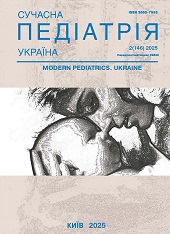Differentiated approach to the prevention and management to metabolically associated fatty liver disease in overweight and obese children
DOI:
https://doi.org/10.15574/SP.2025.2(146).3238Keywords:
children, obesity, overweight, metabolic-associated fatty liver disease, vitamin DAbstract
Obesity is one of the most important public health issues worldwide, affecting people of all age groups.
Aim - to assess the impact of a differentiated approach to the prevention and management of metabolic-associated fatty liver disease (MAFLD) in overweight and obese children, taking into account the presence of vitamin D deficiency.
Materials and methods. The study included 298 overweight and obese children aged 6 to 16 years. A clinical and laboratory examination was conducted. 45 children with MAFLD and vitamin D deficiency were selected and included into the main group. The factor analysis of vitamin D deficiency on the occurrence and course of MAFLD was conducted. Counseling was provided. Vitamin D supplementation was recommended to children with deficiency. Treatment results were assessed based on liver function markers, metabolic parameters, and vitamin D levels.
Results. The frequency of MAFLD in the study cohort reached 27%, vitamin D deficiency was detected in 37% of children. MAFLD and insufficient serum vitamin D levels were identified in 15% of children. Intrauterine growth retardation, excessive consumption of easily digestible carbohydrates and trans fats, sedentary lifestyle and lack of exercise, obesity, prehypertension and prediabetes and specific changes in liver ultrasound as factors associated with MAFLD are likely to occur more often in combination with vitamin D deficiency. Children from main group got supplementation with vitamin D at a dose of 2000 IU for 3 months. Children with overweight/obesity and MAFLD had shown good dynamics of laboratory indicators of alanineaminotransferase level, carbohydrate and lipid profiles. At the same time, obese children had a lower average level of vitamin D (29.3±5.0 ng/l) in blood serum after treatment than overweight children (40.8±4.6 ng/l).
Conclusions. Vitamin D supplementation in children with MAFLD in combination with a standard treatment regimen significantly improved liver function, lipid and carbohydrate metabolism.
The study was conducted in accordance with the principles of the Declaration of Helsinki. The study protocol was approved by the local institutional ethics committee. Informed consent was obtained from the patients (or from the parents or legal guardians of the children) prior to participation.
The authors declare no conflict of interest.
References
Aryayev ML, Selimkhanova DS, Shevchenko IM. (2023). Anxiety level in overweight and obese children. Ukrainian Journal of Perinatology and Pediatrics. 3(95): 61-65. https://doi.org/10.15574/PP.2023.95.61
ElAmrousy D, Abdelhai D, Shawky D. (2022) Vitamin D and nonalcoholic fatty liver disease in children: a randomized controlled clinical trial. Eur J Pediatr. 181(2):579-586. https://doi.org/10.1007/s00431-021-04243-4; PMid:34459959
Ferro D, Baratta F, Pastori D, Cocomello N, Colantoni Aet al. (2020). New Insights into the Pathogenesis of Non-Alcoholic Fatty Liver Disease: Gut-Derived Lipopolysaccharides and Oxidative Stress. Nutrients. 12(9):2762. doi: 10.3390/nu12092762. PMID: 32927776; PMCID: PMC7551294. https://doi.org/10.3390/nu12092762; PMid:32927776 PMCid:PMC7551294
Gou H, Wang Y, Liu Y, Peng C, He W, Sun X. (2023). Efficacy of vitamin D supplementation on child and adolescent overweight/obesity: a systematic review and meta-analysis of randomized controlled trials. Eur J Pediatr. 182(1):255-264. https://doi.org/10.1007/s00431-022-04673-8; PMid:36305951
Liu J, Mu C, Li K, Luo H, Liu Y, Li Z. (2021). Estimating Global Prevalence of Metabolic Dysfunction-Associated Fatty Liver Disease in Overweight or Obese Children and Adolescents: Systematic Review and Meta-Analysis. Int J Public Health. 66:1604371. https://doi.org/10.3389/ijph.2021.1604371; PMid:34690666 PMCid:PMC8527331
Riekki H, Aitokari L, Kivelä L, Lahti S, Hiltunen P, Vuorela N et al.(2023, Jun 20). Prevalence and associated factors of metabolic-associated fatty liver disease in overweight Finnish children and adolescents. Front Endocrinol (Lausanne).14:1090344. https://doi.org/10.3389/fendo.2023.1090344; PMid:37409224 PMCid:PMC10319394
Rudolph B, Selig T, Li Y, Ovchinsky N, Kogan-Liberman D, Liszewski MC et al. (2021).Relationship of Vitamin D Deficiency and Fatty Liver in Children as Defined by Multiple Imaging and Histologic Endpoints. JPGN Rep. 2(2):e077. https://doi.org/10.1097/PG9.0000000000000077; PMid:34723254 PMCid:PMC8553135
Rupasinghe K, Hind J, Hegarty R. (2023, Nov 1). Updates in Metabolic Dysfunction-Associated Fatty Liver Disease (MAFLD) in Children. J Pediatr Gastroenterol Nutr. 77(5): 583-591. Epub 2023 Aug 18. https://doi.org/10.1097/MPG.0000000000003919; PMid:37592398
Sorokman T, Popelyuk N. (2018). Vitamin D as an independent predictor of obesity in adolescents.International journal of endocrinology (Ukraine). 14(5): 449-453. https://doi.org/10.22141/2224-0721.14.5.2018.142679
Stepan MD, Vintilescu ȘB, Streață I, Podeanu MA, Florescu DN. (2023). The Role of Vitamin D in Obese Children with Non-Alcoholic Fatty Liver Disease and Associated Metabolic Syndrome. Nutrients. 15(9):2113. https://doi.org/10.3390/nu15092113; PMid:37432275 PMCid:PMC10181433
Velychko VI, Khatsko VE, Lahoda DO, BazhoraYаI, Pencho GO. (2024). Modern views on metabolic syndrome in children and adolescents. Odessa Medical Journal. 2(187):57-64. https://doi.org/10.32782/2226-2008-2024-2-10
Vos MB, Abrams SH, Barlow SE, Caprio S, Daniels SR, Kohli Ret al. (2017). NASPGHAN Clinical Practice Guideline for the Diagnosis and Treatment of Nonalcoholic Fatty Liver Disease in Children. Journal of Pediatric Gastroenterology and Nutrition. 64(2):319-334. https://doi.org/10.1097/MPG.0000000000001482; PMid:28107283 PMCid:PMC5413933
WHO. (2020). WHO guidelines on physical activity and sedentary behaviour. World Health Organization; Geneva.URL: https://apps.who.int/iris/handle/10665/336656. License: CC BY-NC-SA 3.0 IGO.
WHO. (2023). Health service delivery framework for prevention and management of obesity. Geneva:World Health Organization. Licence: CC BY-NC-SA 3.0 IGO.
World Obesity Federation. (2023). World Obesity Atlas 2023. URL: https://data.worldobesity.org/publications/?cat=19.
Downloads
Published
Issue
Section
License
Copyright (c) 2025 Modern pediatrics. Ukraine

This work is licensed under a Creative Commons Attribution-NonCommercial 4.0 International License.
The policy of the Journal “MODERN PEDIATRICS. UKRAINE” is compatible with the vast majority of funders' of open access and self-archiving policies. The journal provides immediate open access route being convinced that everyone – not only scientists - can benefit from research results, and publishes articles exclusively under open access distribution, with a Creative Commons Attribution-Noncommercial 4.0 international license (СС BY-NC).
Authors transfer the copyright to the Journal “MODERN PEDIATRICS. UKRAINE” when the manuscript is accepted for publication. Authors declare that this manuscript has not been published nor is under simultaneous consideration for publication elsewhere. After publication, the articles become freely available on-line to the public.
Readers have the right to use, distribute, and reproduce articles in any medium, provided the articles and the journal are properly cited.
The use of published materials for commercial purposes is strongly prohibited.

